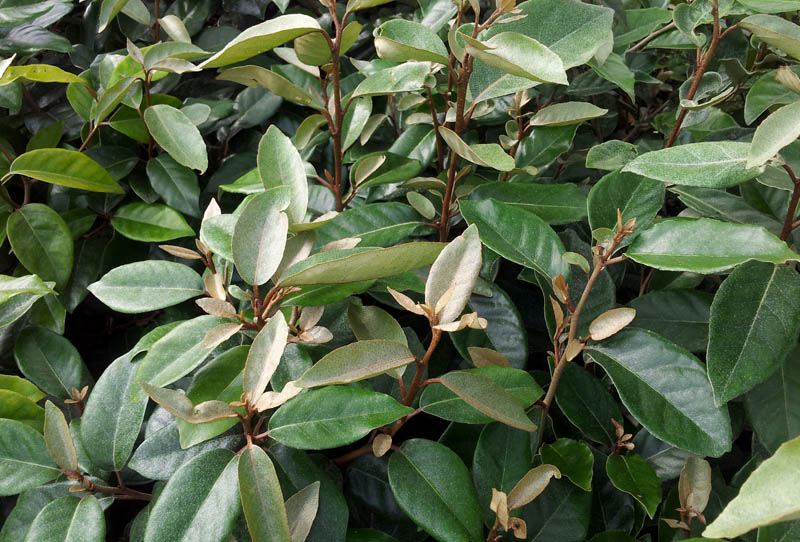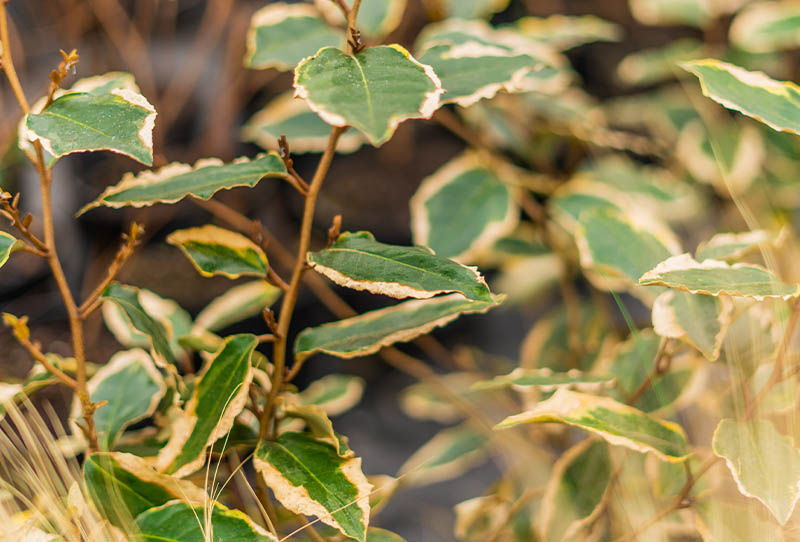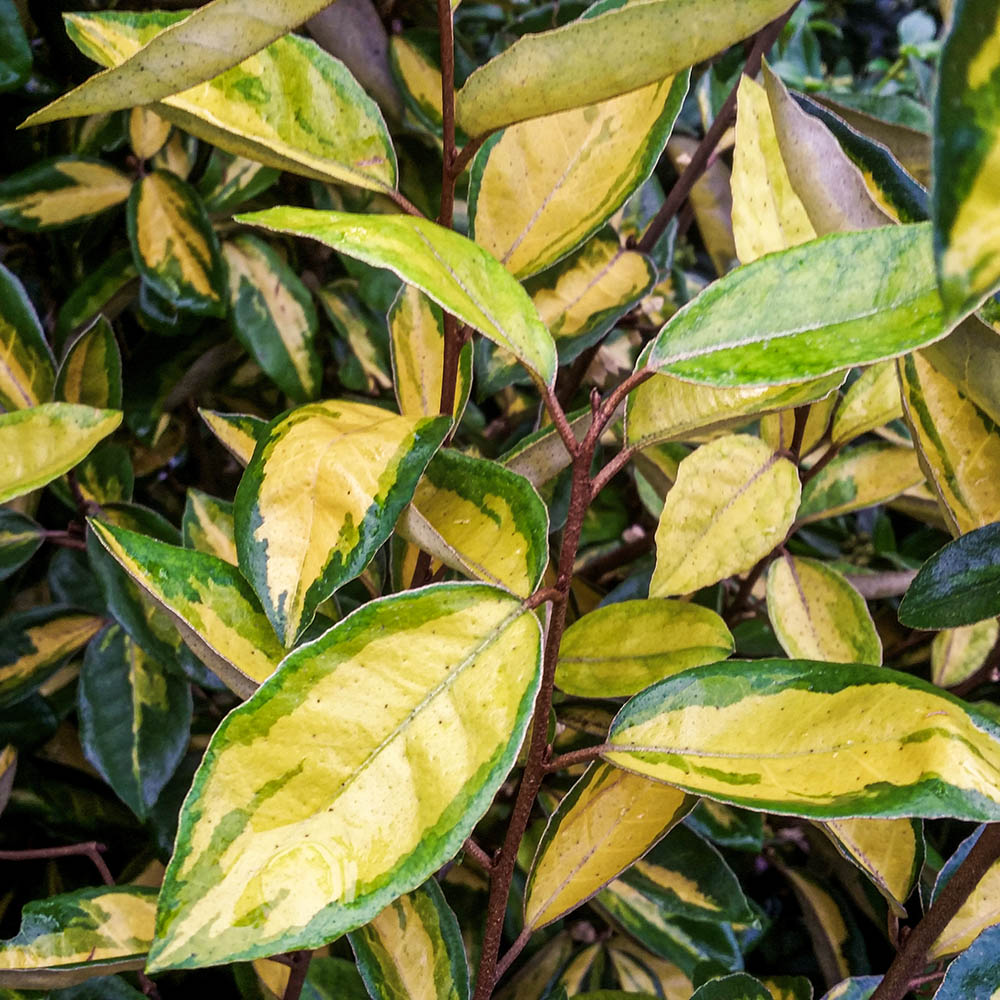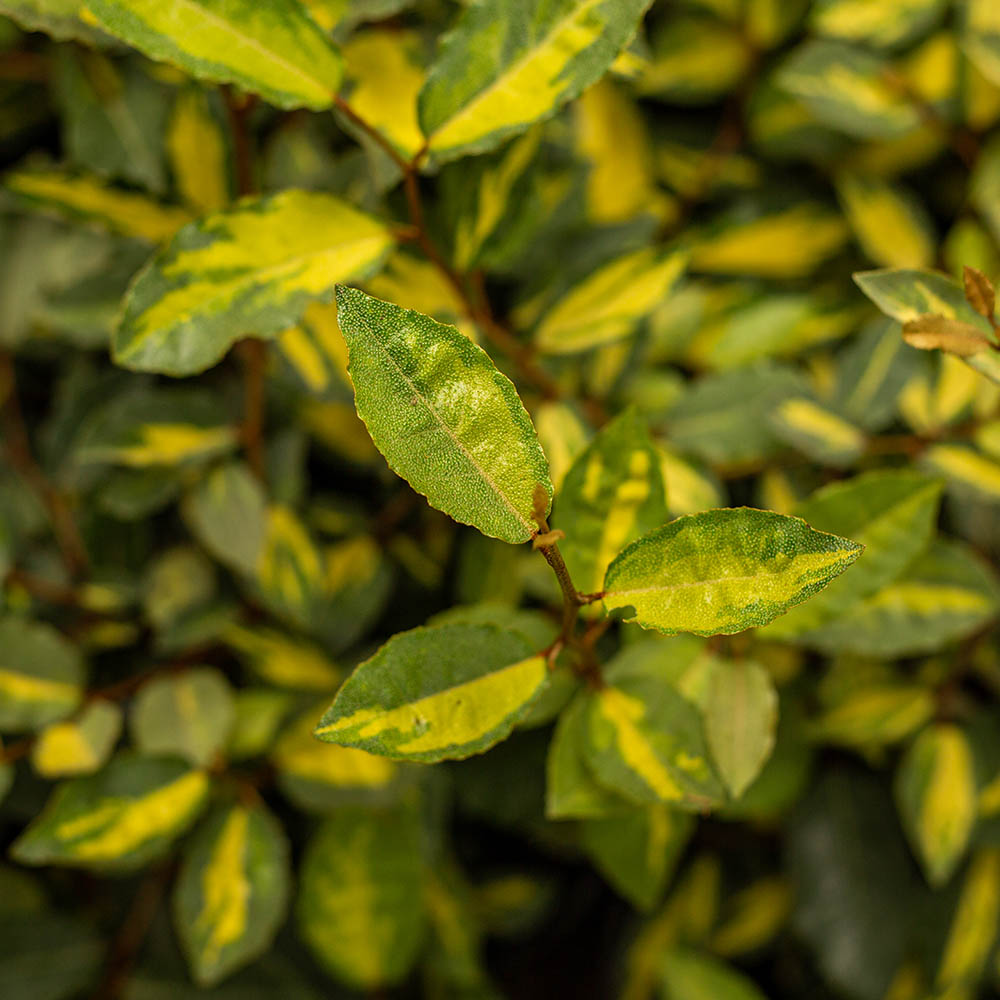Plant Focus: Elaeagnus
A strong, fast–growing hedging plant that’s suitable for coastal environments
Elaeagnus is a genus of around 50 to 70 shrubs and small trees from the Elaeagnaceae family. More commonly known as oleaster, silverthorn, or thorny olive, Elaeagnus can be either evergreen or deciduous, depending on the species and variety. Elaeagnus is not a hugely showy shrub, but some varieties are a great foil for other flowering plants.
The foliage tends to be deep green or variegated, and new shoots can display a metallic silver sheen. Its branches are also slightly twisted in shape. Elaeagnus produces sweetly-scented flowers in the autumn months, with berries which follow in spring – ideal for bringing colour during the colder months of the year. Although Elaeagnus isn’t generally grown for the visual appeal of its flowers, they do provide a pleasant scent, making it ideal for planting near a seating area or entrance. Its flowers are also commonly used in winter floral arrangements.
Native to Asia, Elaeagnus is a structural, versatile plant that’s ideal for growing as a shrub, or for hedging and screening, if kept to an ideal hedge height of around 1.2-2.5m. It grows at a fast rate of around 30 to 60cm per year. Elaeagnus copes well with salt-laden air, strong winds, and pollution, making it an excellent choice for coastal gardens. It’s also a popular planting choice for cottage and wildlife gardens.
Key Characteristics:
✓ Evergreen or deciduous shrub
✓ Height varies from around 2.5m to 4m
✓ Highly scented flowers
✓ Deep green or variegated foliage
✓ Produces spring berries
✓ Low maintenance
✓ Ideal for hedging
✓ Copes well in exposed locations
✓ Provides benefits to wildlife
Did you know?
All Elaeagnus species produce orange-red, cherry-sized fruits which are edible to humans, and can be used to make jams.
Elaeagnus is beneficial to wildlife in a number of ways. Bees and other pollinators are attracted to its flowers, as it offers a fantastic source of pollen and nectar during the time of the year where it can be scarce. Its fruit is adored by birds and helps to sustain them during the colder months. Many wildlife species also use it for protection, shelter, and nesting, due to the density and thorny stems that some species of Elaeagnus offer.
This tough plant species is drought tolerant, shade tolerant, and copes well with coastal winds. This makes it a very useful plant for growing in a variety of difficult planting areas.
Fun fact
Elaeagnus species can improve soil nitrogen through symbiotic relationships; this benefits other nearby plants. As an example, when grown in orchards, apple trees can see their yields increase by 10%.
Species and varieties of Elaeagnus
Elaeagnus × ebbingei
A hybrid of Elaeagnus pungens and Elaeagnus macrophylla, Elaeagnus × ebbingei is a large, rounded, dense shrub that grows up to around 4m in height. Elaeagnus × ebbingei has silver metallic undersides and spots on its foliage. It produces white, scented flowers in autumn, as well as contrasting orange berries in spring. Fantastic for growing as informal hedging and works well for positioning towards the back of a border. In Italy, this plant is often used in topiary.
Elaeagnus × ebbingei ‘Gilt Edge’
A dense evergreen shrub with ovate, dark green foliage with golden yellow margins to contrast. Elaeagnus × ebbingei ‘Gilt Edge’ blooms silver-white flowers in autumn, followed by occasional orange, winter berries. Grows up to around 3m in height.
Elaeagnus × ebbingei ‘Viveleg’
A slightly smaller variety at 2.5m, Elaeagnus × ebbingei ‘Viveleg’ is a tough and reliable evergreen shrub. It has leathery, dark green leaves with yellow margins and metallic silver undersides. Its fragrant white flowers bloom in autumn. Useful for growing as a hedge or specimen plant.

Elaeagnus × ebbingei

Elaeagnus × ebbingei ‘Viveleg’
Elaeagnus × ebbingei ‘Limelight’
A variegated, drought tolerant shrub that grows up to 3m in height. Produces young, lance-shaped silver leaves which are variegated, with bright yellow centres and dark green margins. Elaeagnus × ebbingei ‘Limelight’ blooms small white flowers in autumn. Its strikingly coloured foliage is a lovely addition to a partially shaded spot.
Elaeagnus pungens ‘Maculata’
Commonly known as thorny olive, Elaeagnus pungens ‘Maculata’ is a bushy shrub that has bright yellow foliage with dark green margins. It blooms fragrant, white flowers from mid to late autumn. This particular variety is lovely in winter flower arrangements.

Elaeagnus × ebbingei ‘Limelight’

Elaeagnus pungens ‘Maculata’
How to grow and care for Elaeagnus
Elaeagnus is a versatile planting choice for many conditions; it’s an incredibly hardy plant, and is able to cope with highly exposed positions, as well as frost.
It’s best to plant most Elaeagnus species in full sun or partially shaded spots. Some species, however, such as Elaeagnus × ebbingei ‘Gilt Edge’, can cope in full shade too. They prefer well drained soil, but can handle dry soil as they are particularly tough plants. Avoid planting Elaeagnus varieties in waterlogged soil as they will struggle to thrive under these conditions.
To give Elaeagnus the best chance of successful establishment, it should be planted in either autumn or spring. Elaeagnus requires regular watering once it has been planted. This is very important for exposed areas. However, once it is established, very little maintenance is needed.
Pruning isn’t regularly required to keep Elaeagnus looking its best. However, if a specific shape is desired, Elaeagnus can be cut back annually after flowering. Ensure to mulch annually with compost during the autumn months to give it a boost in nutrients, help it to retain moisture, and suppress weeds.
Pests and diseases which affect Elaeagnus
Elaeagnus varieties are generally pest free but can be affected by coral spot, fungal leaf spot, and the sap-sucking elaeagnus sucker.
Coral spot is a type of fungal disease, caused by the fungus Nectria cinnabarina, that causes affected branches to die back. When identifying coral spot, dieback of branches will be seen, as well as small, pink or red spots on foliage and branches. Raised red spore cases can also be spotted occasionally. The presence of coral spot could indicate that the plant has been weakened by other means. Coral spot can be prevented by ensuring that pruning is only carried out in dry weather conditions, and that clean cuts are made during this process. If coral spot is discovered on the plant, it’s vital to prune out any infected areas and dispose of them correctly.
Originating from eastern Asia, the elaeagnus sucker was first detected in the UK in 2002, and has spread quickly across England and Wales. The elaeagnus sucker covers the plant with honeydew, which can then develop into a black sooty mould. Visually, the elaeagnus sucker affects the plant by causing distorted foliage, with some of its foliage eventually falling. Usually the damage doesn’t reach this point, as thankfully, it’s believed that natural enemies are helping to keep elaeagnus sucker at bay. The elaeagnus sucker doesn’t usually cause harm to the plant’s health. If elaeagnus sucker is present, affected leaves can be removed.
Fungal leaf spot is a fungal infection that can damage and sometimes kill a range of ornamental plants. Leaf spots can display in different colours, such as brown, grey, or black, and can occasionally join together to present as a greater area of dead tissue. Usually, fungal leaf spot can be prevented by growing plants under their optimal conditions. However, if fungal leaf spot is discovered, it’s vital to remove and dispose of all infected parts of the plant, collect and dispose of any infected fallen leaves, and clean any equipment thoroughly before using again.
If you’d like to find out more about Elaeagnus species and varieties which we grow and supply, get in touch with the G Team today.

